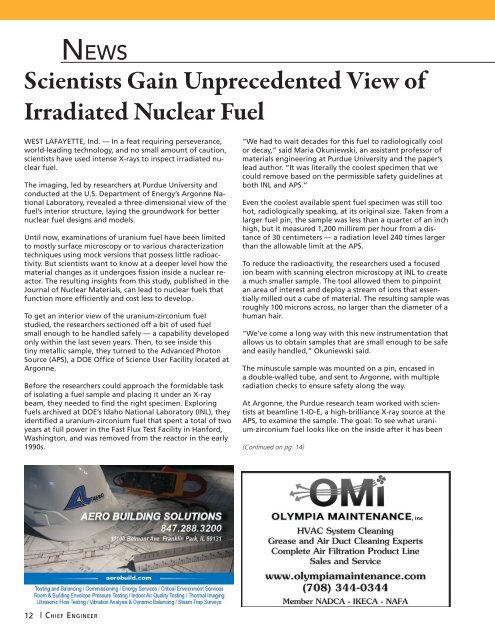CEAC-2021-02-February
Create successful ePaper yourself
Turn your PDF publications into a flip-book with our unique Google optimized e-Paper software.
News<br />
Scientists Gain Unprecedented View of<br />
Irradiated Nuclear Fuel<br />
WEST LAFAYETTE, Ind. — In a feat requiring perseverance,<br />
world-leading technology, and no small amount of caution,<br />
scientists have used intense X-rays to inspect irradiated nuclear<br />
fuel.<br />
The imaging, led by researchers at Purdue University and<br />
conducted at the U.S. Department of Energy’s Argonne National<br />
Laboratory, revealed a three-dimensional view of the<br />
fuel’s interior structure, laying the groundwork for better<br />
nuclear fuel designs and models.<br />
Until now, examinations of uranium fuel have been limited<br />
to mostly surface microscopy or to various characterization<br />
techniques using mock versions that possess little radioactivity.<br />
But scientists want to know at a deeper level how the<br />
material changes as it undergoes fission inside a nuclear reactor.<br />
The resulting insights from this study, published in the<br />
Journal of Nuclear Materials, can lead to nuclear fuels that<br />
function more efficiently and cost less to develop.<br />
To get an interior view of the uranium-zirconium fuel<br />
studied, the researchers sectioned off a bit of used fuel<br />
small enough to be handled safely — a capability developed<br />
only within the last seven years. Then, to see inside this<br />
tiny metallic sample, they turned to the Advanced Photon<br />
Source (APS), a DOE Office of Science User Facility located at<br />
Argonne.<br />
Before the researchers could approach the formidable task<br />
of isolating a fuel sample and placing it under an X-ray<br />
beam, they needed to find the right specimen. Exploring<br />
fuels archived at DOE’s Idaho National Laboratory (INL), they<br />
identified a uranium-zirconium fuel that spent a total of two<br />
years at full power in the Fast Flux Test Facility in Hanford,<br />
Washington, and was removed from the reactor in the early<br />
1990s.<br />
“We had to wait decades for this fuel to radiologically cool<br />
or decay,” said Maria Okuniewski, an assistant professor of<br />
materials engineering at Purdue University and the paper’s<br />
lead author. “It was literally the coolest specimen that we<br />
could remove based on the permissible safety guidelines at<br />
both INL and APS.”<br />
Even the coolest available spent fuel specimen was still too<br />
hot, radiologically speaking, at its original size. Taken from a<br />
larger fuel pin, the sample was less than a quarter of an inch<br />
high, but it measured 1,200 millirem per hour from a distance<br />
of 30 centimeters — a radiation level 240 times larger<br />
than the allowable limit at the APS.<br />
To reduce the radioactivity, the researchers used a focused<br />
ion beam with scanning electron microscopy at INL to create<br />
a much smaller sample. The tool allowed them to pinpoint<br />
an area of interest and deploy a stream of ions that essentially<br />
milled out a cube of material. The resulting sample was<br />
roughly 100 microns across, no larger than the diameter of a<br />
human hair.<br />
“We’ve come a long way with this new instrumentation that<br />
allows us to obtain samples that are small enough to be safe<br />
and easily handled,” Okuniewski said.<br />
The minuscule sample was mounted on a pin, encased in<br />
a double-walled tube, and sent to Argonne, with multiple<br />
radiation checks to ensure safety along the way.<br />
At Argonne, the Purdue research team worked with scientists<br />
at beamline 1-ID-E, a high-brilliance X-ray source at the<br />
APS, to examine the sample. The goal: To see what uranium-zirconium<br />
fuel looks like on the inside after it has been<br />
(Continued on pg. 14)<br />
12<br />
| Chief Engineer


















